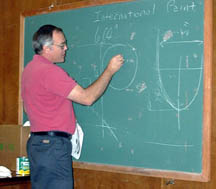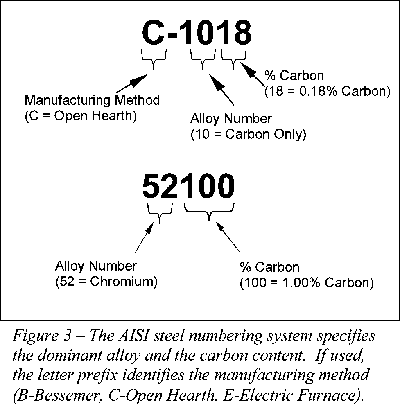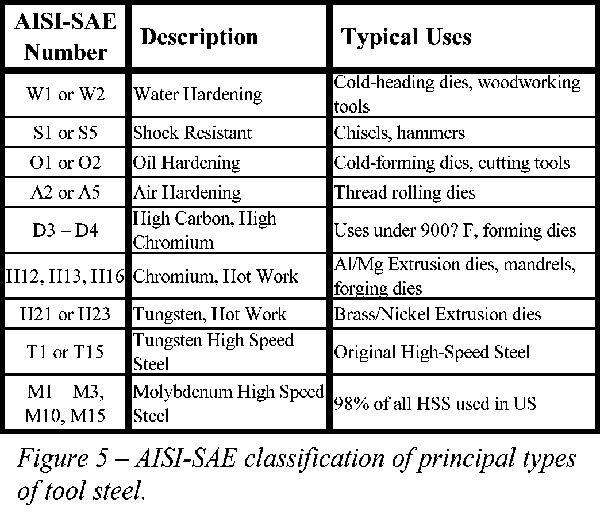

In general, the higher the percentage of the alloy, the greater its
effect on the steel. Similar to carbon, most alloys have a practical
upper limit that is usually less than 2%.
Journal of the Home Metal Shop Club of Houston, Texas. See back page
for meeting information.
President - George Carlson, V. Pres.- J. D. Wise, Treasurer - Gordon
Lawson, Secretary - Keith Mitchell
Editor - Keith Mitchell Hm (281) 391-2406 Wk (713) 215-8123
Email kmitchl@wt.net
Membership Information Membership is open to all those interested in machining metal and tinkering with machines. The purpose of the club is to provide a forum for the exchanging of ideas and information. This includes, to a large degree, education in the art of machine tools and practices. There is a severe shortage of written information that a beginning hobbyist can use. This makes an organization such as this even more important. For membership information and forms, call George Carlson at (281) 376-4606.
Let me tell you about the free lunch I received today.
It all started out a few months ago when a friend of mine, who owned
several horses, took an interest in blacksmithing. His desire, you
see, was to become proficient at the farrier's trade.
Like most things we get into, the process started with reading as much
about the craft as he could find. He asked me if I would help him
build a forge. I told him to order the stuff, I would do the cutting
and welding. An iron fire pot was ordered from Centaur Forge and
the coal fired forge project was begun.
It took most of one Sunday to build the forge, but it turned out quite
nice. In a few days I was beginning to see the fruits of the forge
in the form of homemade bits, bridle parts, weird tongs, and candle holders.
The forge worked well, but still, no free lunch.
Then it happened, what we all have been waiting for. A CUSTOMER!
It turned out that another friend of ours knew of a woman who was building
a super custom kitchen. This is the type where all the cabinets,
vent hoods, and fixtures are all custom made.
There was a rail around the vent hood that was designed to carry special
pot hooks. The pot hooks that the builder supplied just wouldn't
do. They were made of cast iron, not hand forged, and much too factory
made to suit her taste.
So friend number 2 shows this problem to the budding blacksmith, and
eight beautiful and functional pot hooks are produced.
Woman is happy, Blacksmith is paid, and George gets a free lunch.
Life is good.
Minutes of the April Meeting
Reported by: Keith Mitchell
Chips Meeting - 1:00 P.M. April 17, 1999, Oak Forrest Library
Attendance - 28
In the Chips Meeting the following activities took place.
1. Past Issues of HSM and PIM - David Whittaker is in the process of
cataloging the back issues of HSM & PIM. Once cataloged, these will
be available for loan from the club library like the tapes and other publications.
It was agreed that David should purchase suitable magazine boxes and a
container for the library. The current plan is to have members request
specific issues prior to the monthly meeting. David will bring the magazine
to the next meeting.
2. NAMES - Keith Mitchell indicated he planned to attend NAMES in Wyandotte
Michigan April 24 & 25. A meeting of the various metalworking clubs
had been organized with Bob Lorentz of the Metro Detroit Metalworking Club.
The purpose of the meeting is to explore how the clubs can cooperate. Input
of the web address of various other metalworking clubs was requested.
3. Presentations - A presentation on protective coatings and corrosion
control was suggested.
4. Show & Tell - George Carlson brought a pistol rest he had made
several years ago. The elevation on the barrel rest was a double lead screw.
George said he had found he could cut double lead screws by picking up
the thread dial at a different point as opposed to rotating the part in
the chuck by 180 degrees.
5. Woodworkers Club - There was a discussion of how we might cooperate
with the Woodworkers Club. For example, make specialized tools for them
in return for a woodworking project.
6. Presentation - Bill Sperry and John Korman gave a presentation on
drilling. See photos following
7. Newsletter - We are developing a list of resources to assist others
in preparation of newsletter articles. These are people who can do word
processing, CAD drafting, photography, etc. to assist others. The goal
is to provide assistance to those who are willing to prepare an article
but lack some of the skills or equipment required. Volunteers are needed!
8. Address List - The club address list was passed out at the meeting.
Several corrections were received and the list updated.
9. Tom Moore - brought in a quantity of items for sale at bargain prices.
10. May Meeting Presentation - May meeting presentation will be on
welding by Keith Mitchell
11. Library Blackboard - The club donated paint to refinish the Library
Club Room Blackboard. Several club members donated their expertise to repaint
and rehang the board.
NAMES
By: Keith Mitchell
I had the good fortune to attend the North American Model Engineering Exposition (NAMES) this year. This is after three years of making tenative plans and having to cancel for various reasons, usually related to work commitments. NAMES has been held every April for the last ten years. The exposition is held over a Saturday and Sunday.
My mission was two fold. First I had heard a lot about NAMES and wanted to see first hand what it was all about. Second, I had organized a meeting of representatives from various metalworking clubs to explore how we might cooperate.
I departed Houston Saturday morning and arrived in Detroit before noon their time. It's about 15 miles from the airport to Wyandotte where the show is held. I'm sure the way I went was significantly more than 15 miles. A little time studying the map would have prevented this. I arrived at Yack Arena at about 12:30 and registered. The first order of business was to drop off some flyers I had printed concerning the club meeting Sunday morning at the Metro Detroit Metalworking Club table.
There were four seminars scheduled each day. A seminar on EDM was scheduled for 1:00. I was interested in this topic so decided to attend. Bob Langlois gave the presentation on EDM. He published the original articles in HSM on this subject. The HSM articles are focused on a plunge type EDM. Application of the plunge type EDM is primarily for removing broken bolts, taps or drill bits. Bob's current focus is in wire EDM. This type uses a molybednum wire 0.006 dia which uses electrical discharges to erode slots in metals. Applications include machining materials which are too hard to readily machine. I've seen dies of tool steel made using this technique. Bob had hoped to have a working demo of his EDM at the show. It is still in the prototype stage and due to some unforseen difficulties was unable to demo his unit. The seminar was really good. I bought the Village Press book with the collection of his articles before I left the show.
Following the seminar I went to find Bob Lorentz, president of the Metro Detroit Metalworking Club. One thing which would make the show better is if groups of exhibitors were identified on the front of their display table. Once I found Bob, we discussed what we wanted to accomplish at the meeting of clubs Sunday morning.
Rudy Kouhoupt was scheduled for the 3:00 seminar. His topic was his shop layout and it's functionality. Rudy is no different in person than the Rudy of video fame. He turns out his work in a shop which is 8' X 12'. This calls for efficient machine placement and space utilization. Following the Rudy presentation, I spent some time wandering around the show. The models on display were extrodinary. The level of craftsmanship unexcelled. A number of vendors of machinery, books, tools, and casting kits had displays.
Following a good night's sleep, I returned to the Exposition and prepared for the meeting of club representatives. We had sixteen people at the club meeting. Joe Rice, editor of HSM and Machinist Workshop addressed the group and explained how his publications can help clubs. The common thread heard at this meeting was the need for information on how to go about forming a club. . Scott Logan of Logan Actuator offered web space to promote this cause. Separately I have captured the bullet items of this meeting.
The meeting of clubs could have lasted longer but preempted by a 10:00 seminar on model building. Bill Huxtable gave an excellent presentation on model building. He uses a number of form tools for his models. The top of the tool is ground with zero rake. When the tools need sharpening he touches up the top. This avoids having to reshape the tool. He showed some hex head cap screws he made which were 1.2mm in diameter. These are similar to the screws used in glasses hindges. He went through the operations he uses to make stop valves for models.
Following the model building seminar there was a CNC seminar. I sat thru the CNC seminar also. The presentation addressed the CNC options available to the hsm and was excellent. Stepper motors seem to be the preferred method of movement. Kits are available with stepper motor driver outputs of up to 9 amps. The larger the stepper output the greater the torque. They tested a 5 amp stepper system to see what it would pickup. The stepper was fitted to a Bridgeport mill and was picking up a basket of scrap. The weight was incremented. They quit when the weight was in danger of overturning the machine. The other consideration is the programming software. Commercially G code is the standard. Some of the software is not compatible with G code. I have the handout from this seminar if anyone would like a copy.
 in college. Not the structure of exotic alloys, or the
economics of fancy manufacturing methods. It's the basics of
steel that have stayed with me. I've managed to hang on to enough
bits of useful information that I can easily waste a page in the club newsletter.
in college. Not the structure of exotic alloys, or the
economics of fancy manufacturing methods. It's the basics of
steel that have stayed with me. I've managed to hang on to enough
bits of useful information that I can easily waste a page in the club newsletter.
Iron and carbon are inside every piece of steel. The carbon is actually dissolved inside the iron, just like sugar dissolves in water. Of course, iron has to be heated up to a liquid for the carbon to dissolve. The bottom line is, steel is a frozen (solidified) solution of carbon in iron.
Most steel contains more than 90% iron. The carbon content ranges from just above 0% up to 2%, while other alloys bring the total to 100%. Steels with the least amount of carbon are typically softer and more ductile, while higher carbon steels are stronger, harder, and more brittle.
During the steel making process, the iron dissolves the carbon. If there's too much carbon for the iron to dissolve, the carbon precipitates out as flakes or balls such that the mix is more cast iron than steel. This precipitation point occurs at about 2% carbon. As shown in Figure 1, the main difference in wrought iron, steel, and cast iron is their carbon contents.
In addition to carbon, other alloys are typically part of the makeup of steel. Nickel, chromium, manganese, molybdenum, lead, sulfur, and tungsten are just a few of the many elements that are added to provide specific properties to the steel mixture (see Figure 2).


In general, the higher the percentage of the alloy, the greater its
effect on the steel. Similar to carbon, most alloys have a practical
upper limit that is usually less than 2%.
With all of these different alloys, and percent carbon values, a consistent
numbering scheme had to be devised to identify the different types of steel.
This system is made up of a four (sometimes five) digit number that identifies
the dominant alloy and the percent carbon in the steel. In addition,
some steels have a letter prefix that specify its manufacturing method.
As shown in Figure 3, the first two digits specify the main alloy, and
the last two (sometimes three) digits specify the carbon content.
Figure 4 is a table of just some of the steel alloy numbers that a
home shop machinist will encounter. For example, 1018 steel
has no appreciable alloy content and contains 0.18% carbon. 4140
steel is a chromium-molybdenum steel with 0.40% carbon. And
12L14 steel is a leaded steel with 0.14% carbon. The improved
properties of these steels can be found by referring back to Figures 1
and 2 (the chrome-moly in 4140 provides improved hardenability, the lead
in 12L14 steel provides improved machinability, and 1018 is a relatively
soft low carbon steel).
What is referred to as "Plain Carbon Steel" is by far the most common steel that is used in a home shop. It is typically a 10xx steel where carbon is the dominant alloy. "Low Carbon Steel" (0.05% - 0.35% carbon), because of its low carbon content, lacks the ability to become hard. For some manufacturing and welding processes, this property makes it the best choice. Typical applications include pipe, tubing, auto bodies, wire, nails, motor shafts, key stock, angle iron, and channel. Common "Cold Rolled" and "Hot Rolled" steels that are purchased from the local welding shop are additional examples of Low Carbon Steel. Browsing through a typical catalog of an industrial supplier, you'll find "Low Carbon Flat Ground Stock". This is a Low Carbon Steel that has higher than normal levels of sulfur, manganese, and silicon. This provides easier machining, better weldability, and better case hardening.
"Medium Carbon Steel" (0.35% - 0.5% carbon) can be heat treated to provide quite a range of strength and hardness. Typical applications are gears, axles, crankshafts, wheels, forgings and high strength castings.
"High Carbon Steel" (0.5% - 1.0% carbon) is typically heat treated to provide high strength and hardness. Typical applications include springs, knives, chisels, hammers, bandsaw blades, reamers, and other high hardness applications.
"Tool Steel" is a category that is completely separate from any of the above categories. These steels typically have at least 0.6% carbon along with Chromium, Molybdenum, Tungsten, and Vanadium to enhance hardness, wear, and hardenability. Instead of using the "Steel Numbers" (as in Figure 3) they are specified by an AISI-SAE designation as shown in Figure 5.


Most tool steels are designed to be machined in their unhardened state, heat treated, and then ground to final dimensions. Initial machinability, hardenability, and dimensional stability are the key attributes that a machinist reviews in the selection of this material.
Browsing through the catalog of a typical industrial supplier, O1 (oil hardening) and A2 (air hardening) flat stock can be found, along with O1, A2, and W1 (water hardening) drill rod. All of these materials are relatively easy to machine in their unhardened state. The A2 steel typically has the highest carbon content (0.95% - 1.25% C) along with 5% chromium. It provides excellent wear and abrasion resistance and heat treats well. It holds its dimensions very well during heat treating and hardens throughout the finished product. W1 steel has a little less carbon (0.95% - 1.05% C) and has good wear and abrasion resistance. Without a lot of care, longer pieces of W1 will warp during heat treating. This material hardens to only a shallow depth. O1 steel typically has the least carbon of the three (0.85% - 1.0% C) and has good abrasion resistance. It holds dimensions well (better than W1, but not as good as A2) during heat treating, and hardens deeply into the material.

Another tool steel that is worth mentioning is M2. This grade is by far the most widely used high-speed steel. It is a molybdenum type steel with a substantial tungsten content, and has excellent abrasion resistance, strength, and red hardness. It is used for drill bits, milling cutters, lathe tools, and many other metal cutting tools. It usually comes in its hardened state, so the user typically grinds this material to its final size.
In a home shop, choosing the right steel can make a big difference. For some projects, whatever's in the scrap box is good enough. For others, it's worthwhile to do some homework to find the right material. There are a lot of good books that get into the details of metallurgy and material science. The Machinery's Handbook is a good place to start.
 8/10/99
8/10/99